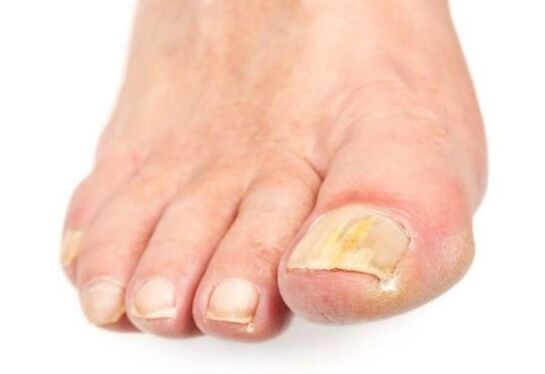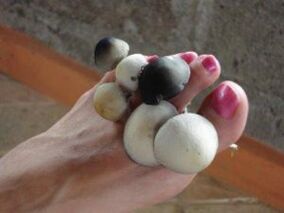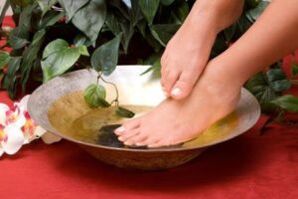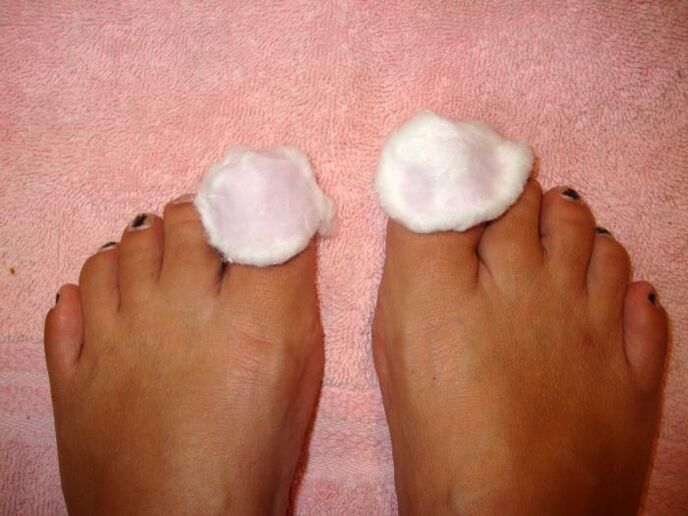Leg fungus occurs in every five people and can be treated promptly at home. In most cases, this pathology is not life-threatening to the patient, but it can cause a lot of discomfort. The fungus Trichophyton rubrum can infect the feet if personal hygiene rules are not followed. Usually, Candida will colonize colonies of this microorganism. As the pathogenic microflora multiplies, toxic toxins are produced, which are carried throughout the body by the blood. They disrupt metabolism and increase the body's sensitivity to external negative factors.

To get rid of this problem quickly, it is necessary to learn more about how to treat leg fungus at home.
How to distinguish fungi from other diseases?
Before starting treatment, it's important to make sure the feet are really affected by the fungus and not another infection. Usually, infection with this microorganism is accompanied by dryness and peeling of the feet. In some cases, the skin may turn red and scales appear between the folds. Diaper rash can occur if a person sweats too much. They are often accompanied by itchy blisters and corns.
Special attention should be paid to the color and shape of the nails. Fungal spores tend to penetrate deep beneath the nail plate. First, yellow streaks appear on the nails, which over time begin to crack and lose their color. A void or broken mixture then forms under the nail. All of these are usually accompanied by an unpleasant odor.

If a person sees these signs in themselves, treatment should be started immediately. At this stage, the infection is easier to heal. One course of antifungal treatment is enough to fix this problem.
If the fungus is neglected, then it can develop into a fungal disease. It can interfere with movement, and sometimes body temperature may increase due to lesions that develop in the body. In some cases, the neglected fungus can trigger the development of psoriasis or eczema.
Treating nail fungus at home should still be started after consulting a specialist. A dermatologist will tell you which body washes and creams to use to remove lesions.
Since the use of home remedies for foot fungus involves the use of products of animal and plant origin, all tests that can eliminate the risk of allergic reactions must be passed.
How to treat nail fungus at home
Treating foot fungus at home should start with disinfection. At the same time, disinfect not only the affected skin area, but also all care items such as feet, shoes, clothes, and bathrooms. The lack of regular disinfection renders the treatment ineffective, causing other family members to contract the disease.
To disinfect the skin, Australian tea tree oil can be used. It perfectly eliminates the inflammatory process caused by fungi, moisturises and softens dry skin. Tea tree oil should be applied to damaged areas 2 times a day for 1-2 months. Constant use of this natural ingredient will help forever forget about fungus, as well as cracks and corns.
It is recommended to add detergent to the laundry for boiling. For 5 liters of boiling water, you need to take 1 teaspoon. Soda water and ¼ bar of laundry soap. If possible, it is recommended to get rid of old socks completely.
Shoes should be regularly treated with 40% acetic acid. With a cotton swab dipped in the substance, it is necessary to wipe the entire inner area of the shoe clean. The used disks should then be thrown away and the new disks should be soaked in acetic acid again, put in boots or shoes and tied in a plastic bag. It is recommended to do this at night so that the entire infection is destroyed by the morning. It is best to wash the insoles regularly. This will help get rid of the pathogenic microflora in the shoes.

Fungus in the bathroom is no less than shoes and clothing. Tiles and all interior items must be cleaned regularly with chlorinated water. You can add some laundry detergent in it. Make sure all surfaces are dry and free of moisture. It is recommended that the bathroom be ventilated frequently to prevent mold growth.
Scissors, brushes and other cosmetics used to treat nails and feet must be placed in alcohol. If the metal composition allows it, it can be sterilized by fire.
All treatments for nail fungus are in vain if you don't follow personal hygiene rules and don't disinfect.
foot bath
Home remedies for toenail fungus can be applied topically (rubbed into the skin) or taken in the bath. This is the most common treatment for this disease. Not only does it help disinfect the skin and nail plate, it also relieves fatigue and swelling. It is best to soak your feet at night. Immediately after this procedure, you need to wrap your limbs in a clean towel and go to bed. For example, if a person puts on their shoes to go to work immediately after taking a shower, there is no point in taking a shower.
There are several proven foot water treatment formulas to consider to eliminate fungus. The most common method is to bathe with salt and soda water. To prepare it, you need to mix the ingredients in equal proportions in hot water, then put the limbs in the basin for 30 minutes. When the water cools, add hot water. After taking a shower, you should rinse your feet with a cool, clean liquid.

Potassium permanganate and mustard baths are also popular. To prepare them you need to take:
- 0. 5 tsp potassium permanganate;
- 1st. l. Crushed laundry soap;
- 1st. l. soda;
- 2 tablespoons. l. Mustard.
All these ingredients must be mixed in 5 warm water. It is necessary to place the legs in the basin with the composition for 20 minutes, then rinse with warm water and dry with a clean towel. This procedure can be done every day until the symptoms of the fungal infection are completely gone.
Every day, you can soak your feet in a sea salt bath (100 grams per 5 liters of water). For better results, you can add 4 tablespoons. l. Apple Cider Vinegar.
An effective home remedy for nail fungus is a milkweed bath. To prepare it, you will grind 100 grams of the leaves and stems of this plant and pour the resulting dry mixture into 3 liters of hot water. In such a mixture, the legs should be held for about 30 minutes, constantly maintaining the temperature of the liquid. You should not do this procedure every day, 2-3 times a week is enough and after 1-2 months there will be no traces of fungus.
Emulsion and Compression
Home remedies for toe fungus can be rubbed into damaged skin regularly. Typically, onion juice or horsetail infusion is used for this purpose. The process is painless and it is recommended to wipe the skin 3-4 times a day with the drug to forget about the fungus forever within a month.

You can make special alcohol tinctures from cloves. 10 mg of raw material must be poured into 100 mg of alcohol and allowed to brew for 10 days. With this solution, you need to lubricate damaged areas of skin and nails for a week.
A compress made with an alcohol tincture is fine. The easiest way to do this is to stir in 1 cup warm water 1 tablespoon. l. Ammonia. This mixture should be soaked thoroughly with gauze and then placed on the affected area of the foot. The legs then need to be wrapped in polyethylene and wrapped in a towel. Instead of the latter, you can use normal thermal socks. This compression should be done at night, 2-3 times a week, until full recovery.
Propolis alcohol tincture has also been shown to be an excellent antifungal agent. She needs to wipe the affected nails daily for 2 months. The effect becomes apparent after the first 2 weeks: the diseased nail plate will gradually start to fall off, while the healthy nail will appear in its place.
Garlic is often used to fight fungi. It must be finely grated and mixed in equal proportions with melted butter. This substance must be prepared immediately before being applied to the skin and should not be stored for long periods of time. The resulting serum should be applied to the painful area daily for 2 weeks.
You can make a therapeutic mixture of peroxides. For this you need:
- 0. 5 cup cooked soda;
- 4 cups hot water;
- ¼ cup hydrogen peroxide (3%);
- 0. 5 cups magnesium sulfate;
- ¼ cup vinegar.
All ingredients, except vinegar, must be well mixed. Vinegar needs to be added last. It is necessary to impregnate a cotton pad with this treatment solution and apply it to the nail plate affected by the fungus. You can stick it on with adhesive. It is best to use this bandage every 10 hours for 1 month.
In the evening, it is recommended to use novocaine to make a lotion. It is enough to simply moisten a cotton swab in the preparation and apply it to the painful area at night. You can use these lotions no more than 2 times a week until symptoms of the disease are completely gone.
antifungal cream
If a person has started to get sick and does not know how to cure the fungus on the skin of the legs at home, to avoid surgery, it is recommended to prepare a tar ointment. Pure substance, powdered yellow sulphur and burnt blue sulphuric acid must be mixed in equal proportions. The finished mass must be boiled. It must then be cooled and applied to the painful area until symptoms of the disease disappear.
Acetic acid ointment will help to overcome the fungus. To prepare it you need to mix:
- 70% acetic acid;
- Dimethyl phthalate;
- glycerin;
- olive oil.
In the process of preparing the ointment, be sure to stick to a 2: 1: 1: 1 ratio. The components do not need to be heat treated, just mix them well. On the affected area, the vinegar ointment must be applied with a cotton swab, left on for about 8 hours, and then carefully removed with laundry soap. It is recommended to apply the drug to the painful area at night.
The fungus can be cured with the help of celandine ointment. For its preparation you will need:
- 5 drops celandine juice;
- 2 drops oregano juice;
- 2 drops of calendula tincture.
- 4 tablespoons. l. Water.
All ingredients must be thoroughly mixed. This ointment should be treated with nails and affected skin 3 times a day.

























